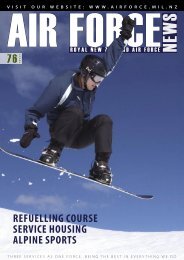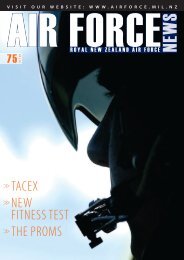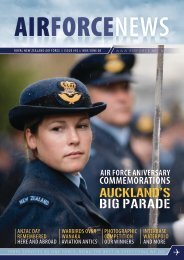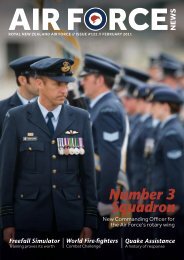ANNIVeRSARY AIR SHow! - Royal New Zealand Air Force
ANNIVeRSARY AIR SHow! - Royal New Zealand Air Force
ANNIVeRSARY AIR SHow! - Royal New Zealand Air Force
You also want an ePaper? Increase the reach of your titles
YUMPU automatically turns print PDFs into web optimized ePapers that Google loves.
The ice runway; note that<br />
a cross wind is blowing!<br />
boeing Flight<br />
by FlTlT Nathan barrack<br />
The boeings’ ice season finished successfully with their last<br />
flight of three to the Ice, in early March. our last flight to and<br />
from Pegasus (one of the Ice runways) this summer season<br />
was done during a small window of forecast good weather.<br />
The crew had to manage their available crew duty time while<br />
also taking into consideration the impending Antarctic night,<br />
the dwindling support on the ice, and forecast bad weather on<br />
the horizon. everything aligned however, and the mission was<br />
completed.<br />
our boeing Ice operations start with high-level meetings<br />
months before, to sort out the number of flights and available<br />
flying hours for supporting the US Antarctic Program and<br />
Antarctic <strong>New</strong> <strong>Zealand</strong>. our ice and cold weather survival<br />
training, along with weather and procedures briefs has to<br />
be fitted in, while the Squadron’s other commitments are<br />
met—No. 40 is a busy squadron that always seems to have<br />
many tasks on the go.<br />
A few clever individuals within boeing Flight have created a<br />
rigid planning cycle worksheet, to minimise possible errors on<br />
the day of each ice flight. Flight plans are run the night before<br />
a flight, so that only a re-run is required at 0500 in the morning<br />
when heads may be groggy. our planning spreadsheets are<br />
then combined with Jeppesens ‘jetplans’ to provide us with<br />
a fuel graph based on forecast winds. This graph is then used<br />
to plot the actual fuel burns against the predicted burn, and<br />
allows us to come up with the all important Point of Safe<br />
Return (PSR).<br />
Antarctic weather is notoriously difficult to predict, and this<br />
16 <strong>Air</strong> <strong>Force</strong> news<br />
NZ7571 and its crew bring the 75th<br />
Anniversary message to the Ice<br />
The b757 is still new<br />
to ice operations;<br />
we first proved<br />
the boeing could<br />
operate there in<br />
2009... however,<br />
there are many<br />
rules and limits in<br />
place to ensure we<br />
are operating safely<br />
and as efficiently as<br />
possible.<br />
is one of the reasons for our weather limits. Not meeting our<br />
weather criteria approaching PSR is the most common reason<br />
for turning around and flying all the way home (which is a 7 hour<br />
round trip using approximately 24 tonnes of fuel on the b757).<br />
Flying to the ice with no alternate runway or airfield<br />
available, often feels like the forecasters are trying to lure<br />
us into some kind of a trap! but of course the forecasters are<br />
trying hard too, yet the fact is that the weather can change<br />
rapidly with little warning.<br />
The b757 is still new to ice operations; we first proved the<br />
boeing could operate there in 2009. but many had thought<br />
sending a civilian-type airliner to Antarctica was ridiculous.<br />
However, there are many rules and limits in place to ensure we<br />
are operating safely and as efficiently as possible.<br />
even though we have an auto pilot, unlimited coffee and<br />
delicious treats being passed forward by the flight stewards at<br />
all times—being awake for such long days takes its toll. early<br />
morning planning, monitoring the weather, the fuel and the<br />
flight’s progress, all combine to be very tiring. we have rest<br />
facilities onboard which extend our crew duty period out to 20<br />
hours. This enables us to delay in the morning, if the weather<br />
isn’t looking great, and attempt a take off later in the day.<br />
cross winds combined with a slippery ice runway at -15ºc<br />
can make for challenging landings. However the aircraft seems<br />
to enjoy the cold turnarounds, but I imagine an overnight stop<br />
for the b757 with blowing snow would be different!<br />
we don’t have as many years of experience with the b757 as<br />
we have with the Hercules—and we don’t have as many engines<br />
either! Yet I have no doubt that we are likely to see more use of<br />
the boeings in this role after another successful season for us<br />
down to “The Ice”.


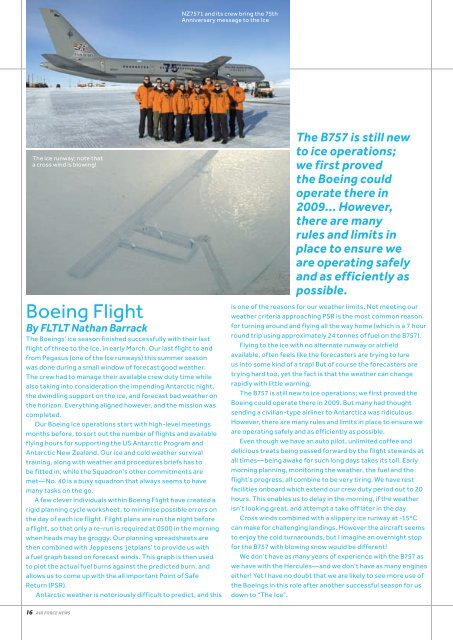
![February 2007, Issue 78 [pdf 3mb, 44 pages] - Royal New Zealand ...](https://img.yumpu.com/17485296/1/184x260/february-2007-issue-78-pdf-3mb-44-pages-royal-new-zealand-.jpg?quality=85)




